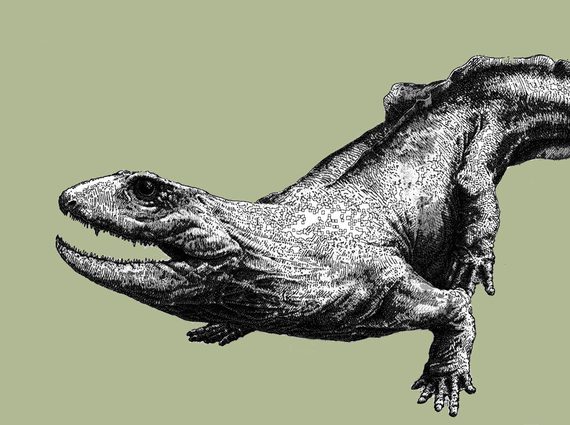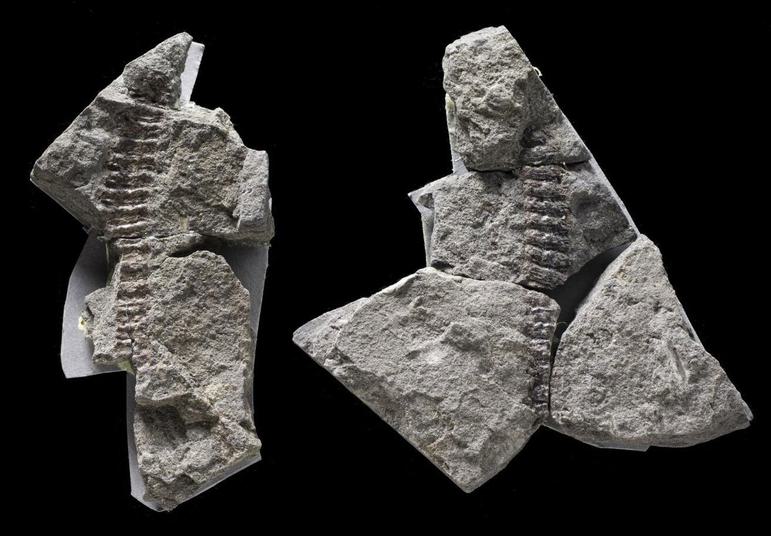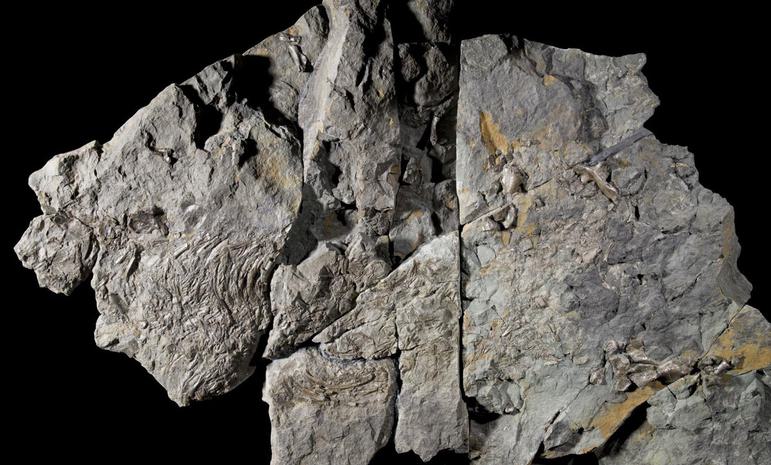
The TWeed project: Evolution’s Missing Chapter
TWeed (Tetrapod World: early evolution and diversity), was a significant collaborative project with five partner organisations to investigate how the earliest tetrapods evolved.
Last updated: 3 February 2025
About the project
National Museums Scotland houses a world-class collection of Palaeozoic fishes and early tetrapods (back-boned animals with four limbs) and for many years this has been the focus of a number of major research programmes by scientists around the world.
The earliest tetrapods evolved from a particular group of fish that possessed fleshy lobed fins. These animals probably used their limbs to “scramble” over the beds of lakes and river systems, but they would have lacked any capacity to move across dry land. However, in time, and with fully-developed lungs, we believe that new forms evolved that lived and looked much more like amphibians do today. This process began about 360 million years ago. But under what circumstances did it take place and what was the Earth like at this time?
- Project title
The TWeed project: Evolution’s Missing Chapter
- Project active
2012 - 2016
- Research theme
Sustainability
- Project website
Contributors
Prof. Jenny Clack - Principal Investigator - The University of Cambridge (deceased)
Dr Nick Fraser - National Museums Scotland
Dr Andrew Ross - National Museums Scotland
Dr Stig Walsh - National Museums Scotland
Prof. Sarah Davies - The University of Leicester
John Marshall - The University of Southampton
David Millward - The British Geological Survey (retired)
Publications
Clark, N.D.L. & Ross, A.J. 2024. Caridoid crustaceans from the Ballagan Formation (Tournaisian, Lower Carboniferous) of Willie’s Hole, Chirnside, Scottish Borders, UK. Earth and Environmental Science Transactions of the Royal Society of Edinburgh, FirstView. https://doi.org/10.1017/S1755691024000045
Bennett, C.E., Kearsey, T.I., Davies, S.J., Leng, M.J., Millward, D., Smithson, T.R., Brand, P.J., Browne, M.A.E., Carpenter, D.K., Marshall, J.E.A., Dulson, H. & Curry, L. 2021. Palaeontology and palaeoenvironment of Mississippian coastal lakes and marshes during the early terrestrialisation of tetrapods. Palaeogeography Palaeoclimatology Palaeoecology564: https://doi.org/10.1016/j.palaeo.2020.110194
Dickson, B. V., Clack, J.A., Smithson, T.R. & Pierce, S.E. 2021. Functional adaptive landscapes predict terrestrial capacity with origin of limbs. Nature 589: 242-245.
Johanson, Z., Jeffery, J., Challands, T., Pierce, S.E. & Clack J.A. 2020. A new look at Carboniferous rhizodont humeri (Sarcopterygii; Tetrapodomorpha). Journal ofVertebrate Paleontology40 (3): https://doi.org/10.1080/02724634.2020.1813150
Challands, T.J., Smithson, T.R., Clack, J.A., Bennett, C.E., Marshall, J.E.A., Wallace-Johnson, S.A. & Hill, H. 2019. A lungfish survivor of the end-Devonian extinction and an Early Carboniferous dipnoan radiation. Journal of Systematic Palaeontology 17 (21): 1825-1849.
Clack J.A., Bennett, C.E., Davies, S.J., Scott, A.C., Sherwin, J.E & Smithson, T.R. 2019. A Tournaisian (earliest Carboniferous) conglomerate-preserved non-marine faunal assemblage and its environmental and sedimentological context. PeerJ 6: https://doi.org/10.7717/peerj.5972
Marshall, J.E.A., Reeves, E.J., Bennett, C.E., Davies, S.J., Kearney, T.I., Millward, D., Smithson, T.R. & Brown, M.A.E. 2019. Reinterpreting the age of the uppermost ‘Old Red Sandstone’ and Early Carboniferous in Scotland. Earth and Environmental Science Transactions of the Royal Society of Edinburgh 109: 265-278.
Millward, D., Davies, S.J., Brand, P.J., Browne, M.A.E., Bennett, C.E., Kearsey, T.I., Sherwin, J.E. & Marshall, J.E.A. 2019. Palaeogeography of tropical seasonal coastal wetlands in northern Britain during the early Mississippian Romer’s Gap. Environmental Science Transactions of the Royal Society of Edinburgh 108: 279-300.
Otoo, B.K.O., Clack, J.A., Smithson, T.R., Bennett, C.E., Kearsey, T.I, & Coates, M. I. 2019. An early post-Devonian vertebrate fauna preserved in a Scottish floodplain deposit. Palaeontology 62: 225-253.
Clack, J.A., Porro, L.B. & Bennett, C.E. 2018. A Crassigyrinus-like jaw from the Tournaisian (Early Mississippian) of Scotland. Earth and Environmental Science Transactions of the Royal Society of Edinburgh 108: 37-46.
Chen, D., Alavi, Y., Brazeau, M.D., Blom, H., Millward, D. & Ahlberg, P.E. 2018. A partial lower jaw of a tetrapod from “Romer’s Gap”. Earth and EnvironmentalScience Transactions of the Royal Society of Edinburgh 108: 55-65.
Millward, D., Davies, S.J., Williamson, F., Curtis, R., Kearsey, T.I., Bennett, C.E., Marshall, J.A.E. & Brown, M.A.E. 2018. Early Mississippian evaporites of coastal tropical wetlands. Sedimentology65: 2278-2311.
Richards, K.R., Sherwin, J.E., Smithson, T.R., Bennion, R.F., Davies, S.J., Marshall, J.E.A. & Clack, J.A. 2018. Diverse and durophagous: Early Carboniferous chondrichthyans from the Scottish Borders. Earth and Environmental Science Transactions of the Royal Society of Edinburgh 108: 67-87.
Ross, A.J., Edgecombe, G.B., Clark, N., Bennett, C.E., Carrio, V., Contreras-Izquierdo, R. & Crighton, B. 2018. A new terrestrial millipede fauna of the earliest Carboniferous (Tournaisian) age from southeastern Scotland helps fill ‘Romer’s Gap’. Environmental Science Transactions of the Royal Society of Edinburgh 108: 99-110.
Smithson, T. R. & Clack, J. A. 2018. A new tetrapod from Romer’s Gap reveals an early adaptation for walking. Earth and Environmental Science Transactions of the Royal Society of Edinburgh 108: 89-97.
Bennett, C.E., Howard, A.S., Davies, S.J., Kearsey, T.I., Millward, D., Brand, P.J., Browne, M.A.E., Reeves, E.J. & Marshall, J.A.E. 2017. Ichnofauna record cryptic marine incursions onto a coastal floodplain at a key Mississippian tetrapod site. Palaeogeography Palaeoclimatology Palaeoecology468: 287-300.
Smithson, T.R., Browne, M.A.E., Davies, S.J., Marshall, J.E.A., Millward, D., Walsh, S.A. & Clack J.A. 2017. A new Mississippian tetrapod from Fife,Scotland, and its environmental context. Papers in Palaeontology3: 547-557.
Bennett, C.E., Kearsey, T.I., Davies, S.J., Millward, D., Clack, J.A., Smithson, T.R. and Marshall, J.E.A. 2016. Early Carboniferous sandy siltstones deposited in seasonal flooding episodes preserve rare non-marine fossils. Sedimentology 63: 1677-1700.
Clack, J.A., Bennett, C.E., Carpenter, D.K., Davies, S.J., Fraser, N.C., Kearsey, T.I., Marshall, J.E.A., Millward, D., Otoo, B.K.A., Reeves, E.J., Ross, A.J., Ruta, M., Smithson, K.Z., Smithson, T.R. & Walsh, S. 2016. Phylogenetic and environmental context of a Tournaisian tetrapod fauna. Nature Ecology and Evolution1https://doi.org/10.1038/s41559-016-0002
Kearsey, T.I., Bennett, C.E., Millward, D., Davies, S.J., Gowing, C.J.B., Kemp, S.J., Leng, M.E., Marshall, J.E.A. & Browne M.A.E. 2016. The terrestrial landscapes of tetrapod evolution in earliest Carboniferous seasonal wetlands of S.E. Scotland. Palaeogeography Palaeoclimatology Palaeoecology457: 52-69
Anderson, J.S., Smithson, T.R., Mansky, C.F., Meyer, T. & Clack, J.A. 2015. A diverse tetrapod fauna at the base of Romer’s Gap. PlosOne: https://doi.org/10.1371/journal.pone.0125446
Smithson, T.R., Richards, K.R. & Clack, J.A. 2015. Lungfish diversity in Romer’s Gap: reaction to the end-Devonian extinction. Palaeontology59: 29-44.
Millward, D., Kearsey, T.I. & Browne, M.A.E. 2013. Norham West Mains Farm Borehole: operations report. British Geological Survey Internal Report IR/13/033.
Smithson, T.R., Wood, S.P., Marshall, J.E.A., & Clack, J.A. 2012. Earliest Carboniferous tetrapod and arthropod faunas populate Romer’s Gap. Proceedings ofthe National Academy of Sciences USA109: 4532-4537.
Romer’s gap
Until now we have had very little information to help us answer these questions. The early Carboniferous (from 360 to 345 million years ago) is historically known not only for its extreme scarcity of tetrapod fossils, but also the rarity of terrestrial invertebrates. The period is often referred to as Romer’s Gap after the great American vertebrate palaeontologist Alfred Sherwood Romer, who first recognized that this represented one of the most significant gaps in our understanding of the evolution of life on earth.
Just what went on in this interval has remained a mystery to palaeontologists, yet it was a pivotal step for the evolution of life on land and without this step the world would have been a very different place today. Now, for the first time, new fossils from the Scottish Borders, promise to reveal a much clearer picture of terrestrial life at this time.

New discoveries
The fossils were discovered by the renowned field palaeontologist, Stan Wood, who sadly died in 2012 but left an amazing legacy. They include plants, scorpions, myriapods, fishes and of course several of the elusive tetrapods. The find has been hailed by Sir David Attenborough as very exciting. He wrote, “The fact that they shed light on a part of geological history that hitherto has been almost blank makes Stan Wood’s discoveries of world-wide importance”.

TWeed – Tetrapod World: early evolution and diversification
The scientific significance of the finds cannot be overestimated and an expert group of scientists was assembled to research the fossils. Operating under the acronym TWeed – Tetrapod World: early evolution and diversification – the project involved twelve scientists from across the UK, funded by the Natural Environment Research Council.
The consortium was led by the late Prof. Jenny Clack and involved scientists from National Museums Scotland, the British Geological Survey and the universities of Leicester, Cambridge and Southampton.
Over four years the TWeed team studied the fossils and searched for others. Team members investigated the environmental, depositional and climatic context in which this momentous episode took place.
Project contact
Dr Nick Fraser
Supported by
Natural Sciences news and stories
- Discover

The mysterious 15 million year gap in our evolution
If the first four-legged animals had never emerged from water onto land, our world today would not exist. Yet how did this great step happen? For decades, scientists didn’t know. Now, the mystery is finally being solved – and fossils… - Discover

Meet ‘Lizzie’, a 345 million year old fossil
In the 1980s, a very important fossil was discovered in Scotland. Named Westlothiana, the fossil got its nickname 'Lizzie' because it looked so lizard-like. But don't let the name fool you. It was thought to be the oldest known reptile,… - Discover
10 species spotted on the grounds of the National Museums Collection Centre
Across our sites, we're working to support the local biodiversity. Here’s a look at just a few of the species that can newly be found at the National Museums Collections centre.


